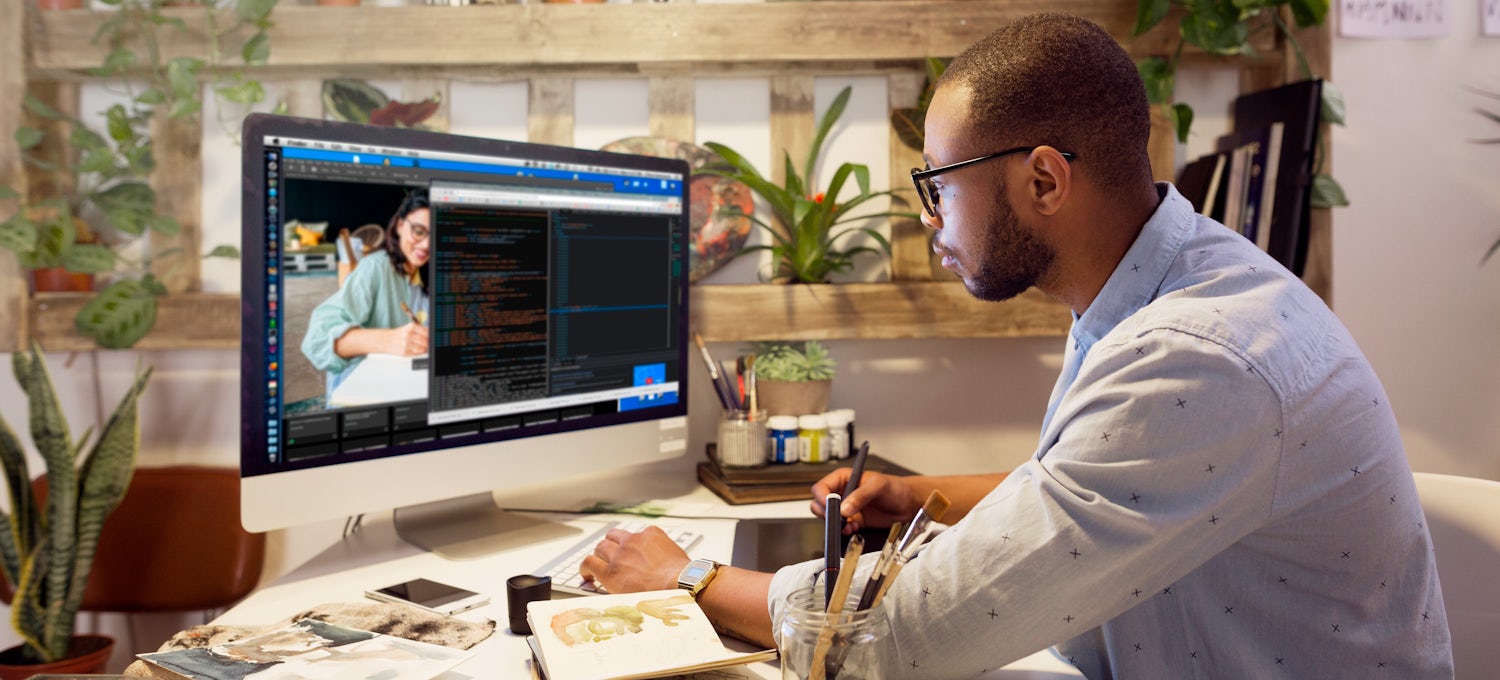Checking Out Creative Fads in Web Design for Modern Companies
The landscape of web design is constantly developing, showing the vibrant needs of modern-day organizations. Current patterns highlight a choice for minimalism, bold typography, and engaging interactivity. Companies increasingly prioritize user experience with mobile-first principles and customized material. Additionally, a focus on sustainability is acquiring traction. Understanding these patterns is essential for organizations aiming to attract attention in a congested market. What ramifications do these shifts hold for the future of digital involvement?
Welcoming Vibrant Typography
Vibrant typography has actually become a specifying element in modern web design, catching focus and communicating messages with striking clearness. This trend prioritizes visually impactful message that improves user involvement and brand name identification. Designers often use large typefaces and special fonts to create a power structure, directing viewers with web content effortlessly.
The calculated use strong typography enables reliable storytelling, enabling brands to communicate their worths succinctly. It offers not only aesthetic objectives yet likewise useful ones, as it boosts readability throughout gadgets and display dimensions.
As websites complete for user interest, vibrant typography stands out in a saturated electronic landscape. Its flexibility allows designers to explore contrasting designs and shades, better amplifying its effectiveness. Ultimately, embracing bold typography represents a change towards more communicative and expressive web design, cultivating a much deeper connection in between brand names and their target markets.
The Increase of Minimalist Design
As digital environments become significantly messy, the increase of minimal layout provides a renewing alternative that focuses on simpleness and functionality. This style viewpoint strips away unneeded aspects, permitting content to take facility phase. By concentrating on tidy lines, enough white room, and a limited color combination, minimalist design improves user experience and enhances navigation.
Companies embracing this pattern goal to convey their brand name message clearly and successfully, cultivating a sense of calm and quality. The absence of disturbances helps users concentrate on important information, bring about improved interaction and conversion rates. In addition, minimal style lines up well with mobile-first strategies, ensuring that internet sites stay user-friendly and obtainable throughout numerous devices.
Eventually, the increase of minimalist design reflects a wider shift towards focusing on user needs and choices, making it a powerful tool for modern services seeking to make a long lasting influence in the digital landscape.
Immersive Animations and Interactivity
While many internet designers accept minimal aesthetic appeals, one more engaging pattern getting grip is the use of immersive computer animations and interactivity. This approach boosts user engagement by creating fascinating experiences that attract visitors into the web content. Developers utilize vibrant aspects such as animated backgrounds, scrolling effects, and interactive infographics to communicate intricate ideas in an available way.
These animations not only provide aesthetic rate of interest but also guide individuals with the navigation process, making communications more instinctive. For example, float impacts and animated shifts can encourage individuals to check out better, bring about boosted time spent on the website.
This pattern lines up with the more comprehensive motion in the direction of narration in internet design, where computer animations serve as narrative tools that convey brand name messages properly. By integrating immersive animations and interactivity, organizations can differentiate themselves in a crowded online landscape, inevitably boosting user fulfillment and brand loyalty.
Mobile-First Style Principles
Mobile-first design principles stress focusing on user experience by guaranteeing sites operate seamlessly on smaller displays. This technique includes receptive format strategies that adjust to various gadget dimensions while maintaining aesthetic integrity. Furthermore, it concentrates on touchscreen navigation layout, boosting functionality for mobile individuals.
Focusing On User Experience
Just how can developers properly prioritize user experience in an increasingly mobile-centric globe? Stressing mobile-first layout principles is vital, as customers primarily engage with internet sites through mobile devices. This strategy motivates designers to enhance material, guaranteeing it is conveniently available and accessible on smaller sized screens. Key methods include simplifying navigation, decreasing lots times, and employing touch-friendly components that enhance interactivity. In addition, focusing on clear typography and instinctive designs can significantly boost user fulfillment. Developers should continually collect user feedback to fine-tune their strategies, adjusting to evolving user requirements and preferences. By concentrating on these elements, services can create an engaging electronic experience that fosters loyalty and drives conversions, ultimately lining up with the expectations of today's mobile users.
Receptive Format Methods
Developers welcome responsive design strategies to produce versatile and adaptive web experiences that deal with my latest blog post various screen dimensions. This approach focuses on mobile-first design concepts, making certain peak performance on smaller sized devices before scaling up for larger screens. By using liquid grids, adaptable photos, and media queries, designers can preserve a natural visual identification across all platforms. This approach not only boosts user involvement yet additionally boosts online search engine positions, as mobile-friendly websites are preferred by search formulas. Furthermore, receptive designs allow organizations to get to a wider target market, fitting users on mobile phones, tablets, and desktops alike. On the whole, carrying out these strategies is important for contemporary web design, making sure that businesses stay affordable site here in an ever-evolving electronic landscape.
Touchscreen Navigating Style
With the surge of mobile phones, touchscreen navigation has actually become a basic facet of web design. Designers are increasingly adopting mobile-first principles to boost user experience and involvement. web design company. Efficient touchscreen navigation prioritizes bigger buttons and instinctive motions, permitting users to engage quickly with web content. This method decreases stress and motivates exploration, as users can browse seamlessly with their fingers. Furthermore, incorporating swipe motions and tap functionality accommodates the all-natural habits of mobile users. Comments mechanisms, such as aesthetic signs and computer animations, enhance use additionally by verifying activities. As touchscreens control user communications, employing these style components not just straightens with modern assumptions yet additionally promotes an extra satisfying and obtainable browsing experience for all individuals
Individualized User Experiences
What makes a customer feel absolutely involved on an internet site? The answer commonly hinges on customized user experiences. By customizing content and navigation to specific choices, companies can develop a meaningful link with their target market. This customization can be accomplished with various methods, such as analyzing user actions, using cookies, and using personalized suggestions based on previous interactions.
As an example, ecommerce platforms that suggest products based on surfing history not only improve user experience yet likewise raise conversion rates. Incorporating dynamic web content that adapts to the user's area or time of day can further enrich interaction.
Furthermore, personalized greetings or messages can make customers feel valued and recognized. As modern organizations seek to stick out in an affordable electronic landscape, embracing tailored user experiences becomes essential, fostering loyalty and check here encouraging repeat brows through. Inevitably, this approach changes a basic internet site right into an interactive platform that resonates with its audience.
Sustainability in Web Design
As the digital landscape remains to progress, the significance of sustainability in web design has actually acquired significant interest. Developers are increasingly familiar with the ecological influence their productions can have, triggering a shift towards environment-friendly methods (Web Design Agency). Sustainable web design concentrates on maximizing internet sites to decrease power consumption and carbon impacts. Strategies include making use of minimalistic layout concepts, optimizing photos, and employing effective coding methods to boost loading speeds
Furthermore, the selection of hosting carriers plays a crucial role; lots of designers are now going with environment-friendly hosting services powered by sustainable energy. By prioritizing accessibility and easy to use navigating, lasting designs additionally satisfy a wider audience, enhancing use. This mindful approach not only attract environmentally-minded consumers yet likewise adds to the overall durability and efficiency of websites. Ultimately, sustainability in web design shows an expanding pattern towards responsible digital methods that align with modern service worths.

Often Asked Questions
Just How Can I Select the Right Color Design for My Internet site?
To select the ideal color pattern for a site, one need to think about the brand's identity, target market, and emotional effect. Utilizing color theory and screening combinations can enhance user experience and visual appeal considerably.
What Are the most effective Tools for Prototyping Website Design?
The finest tools for prototyping website design include Figma, Sketch, Adobe XD, and InVision. These systems offer intuitive user interfaces, collaboration attributes, and considerable collections, making them optimal for developers to develop and fine-tune their concepts properly.
Just how Do I Gauge the Efficiency of My Web Design?
To determine web design effectiveness, one must evaluate user engagement metrics, conversion rates, and usability comments (Web Design services). A/B testing and heatmaps can likewise supply insights right into user habits, directing required modifications for improved performance and user experience
What Prevail Web Design Errors to Prevent?
Typical web design mistakes include messy designs, poor navigating, slow-moving packing times, absence of mobile optimization, inadequate contrast, and neglecting user comments. Preventing these challenges enhances user experience and raises general efficiency of the website.
Just how Commonly Should I Update My Internet Site Style?
A web site design ought to be upgraded every a couple of years, or sooner if considerable modifications in branding or modern technology take place. Regular updates maintain the site fresh, useful, and aligned with present user expectations.
